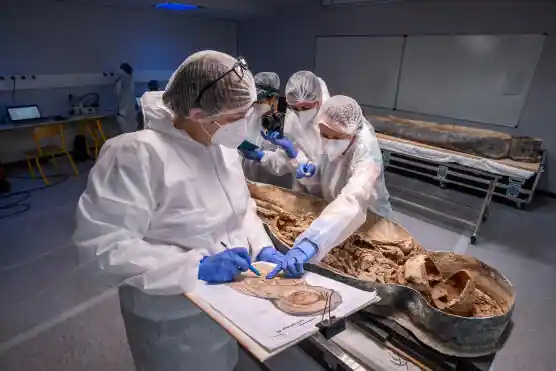
Paris, September 18, 2024 — In a remarkable archaeological breakthrough, researchers have identified the occupant of one of the two leaded coffins unearthed beneath Notre-Dame Cathedral as Joachim Du Bellay, the esteemed French Renaissance poet.
The discovery, revealed in a report on September 17, 2024, sheds new light on the enigmatic figure whose final resting place had remained a mystery for centuries.
The French National Institute of Preventive Archaeological Research (Inrap) announced that Du Bellay, who passed away on January 1, 1560, at the age of approximately 35, is now believed to be entombed in the coffin found under the transept crossing of Notre-Dame.
This revelation follows an extensive investigation conducted after the devastating fire that ravaged the cathedral on April 15, 2019.
Unearthing the Past
The excavation of Notre-Dame’s transept crossing, which began in early 2022, was part of preparatory work for the installation of a 700-ton scaffolding necessary for the rebuilding of the spire.
During this process, archaeologists unearthed eight graves, reflecting the cathedral’s historical role as a necropolis between the 14th and 18th centuries. Among these graves were two leaded coffins, indicating the occupants held significant status.
The first coffin was swiftly identified as belonging to Antoine de la Porte, a canon of Notre-Dame who died in 1710.
His identity was confirmed through a plaque and a smaller epitaph attached to the coffin. However, the second coffin, smaller and more mysterious, posed a challenge for researchers.
The coffin’s occupant, dubbed “The Horseman” by the research team, was revealed to have suffered from tuberculosis of the bones and had a pronounced skeletal deformity from years of intense horse riding. The coffin’s relocation to a previously used burial site further added to the mystery surrounding its occupant.
Piecing Together the Puzzle
Eric Crubézy, a medical doctor and Professor of Anthropology at Toulouse’s Paul-Sabatier University, led the investigation that ultimately identified the occupant as Joachim Du Bellay. Crubézy’s team utilized a combination of historical records and forensic analysis to make this identification.
Du Bellay, renowned as one of the most influential poets of the Pléiade group, was not only a literary figure but also had ties to the ecclesiastical elite.
His uncle, Jean Du Bellay, was a prominent bishop of Paris, cardinal, and dean of the Sacred College in Rome, making him a significant figure in both religious and political spheres.
Historical records indicate that Joachim Du Bellay was buried at Notre-Dame in the chapel of Saint-Crépin on January 2, 1560.
This location was confirmed by a document detailing the chapter’s consent, a record maintained by the college appointed by the pope to oversee burial arrangements.
Historical Significance
The identification of Du Bellay’s remains adds a profound layer of historical significance to the Notre-Dame excavations. Du Bellay was not only celebrated for his contributions to French literature but also for his influential role in the Renaissance cultural revival.
His poetry, characterized by its classical references and innovative style, made a lasting impact on French literature.
This discovery also underscores the importance of Notre-Dame Cathedral as a repository of historical and cultural heritage.
The cathedral, a symbol of Gothic architecture and a focal point of French history, continues to yield valuable insights into the lives of those who shaped its rich legacy.
Future Implications
The findings from Notre-Dame’s excavation offer a glimpse into the cathedral’s historical past, enriching our understanding of the figures who once walked its hallowed grounds.
As restoration efforts continue, these revelations provide a tangible connection to the historical narrative of one of Paris’s most iconic landmarks.
The research team’s work is a testament to the intersection of archaeology, history, and literature, demonstrating how scientific inquiry can illuminate the past in unexpected and meaningful ways.
As Notre-Dame undergoes its transformation and recovery, the discovery of Joachim Du Bellay’s remains serves as a poignant reminder of the cathedral’s enduring legacy and the historical figures who have contributed to its storied history.
For further information on the excavation and its findings, and to explore more about the research conducted, interested parties can contact Inrap or refer to their latest publications and reports.
This article was created using automation technology and was thoroughly edited and fact-checked by one of our editorial staff members